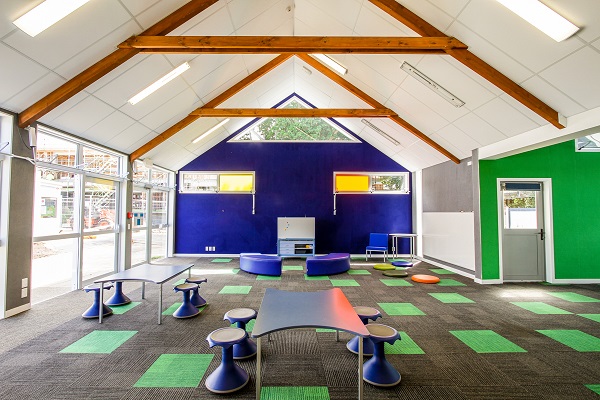
Ellerslie School had problems with the acoustics in its shared learning spaces
Children are inefficient listeners who require optimal acoustic conditions in order to hear and understand (Valentine, Halstead, McGunnigle, Dodd, Hellier, Wood & Simpson, 2002). They are neurologically undeveloped and lack experience to predict from context; especially younger students who are only starting to grasp the basics of comprehension. Children who miss key words, phrases and concepts because of poor listening conditions may do poorly academically and suffer from behavioural problems.
Innovative Learning Spaces (ILS) are emerging as a favoured classroom type to facilitate group work and benefit the children’s social development, promoting the sharing of skills, ideas and experiences. This takes place in open-plan environments where several class-bases share the same space, resulting in a large number of children in one larger area.
However, many acoustic issues arise with ILSs, such as high noise levels coming from other class-bases in the same space. Acoustic conditions often do not facilitate a good signal to noise, especially further away from the teacher. This can be especially problematic for children who struggle to separate the signal from background noise. Furthermore, the larger spatial volumes lead to higher reverberation times that negatively affect speech intelligibility. Longer reverberation times also exacerbate background noise. AS/NZS 2107 recommends a reverberation time of 0.4-0.5 seconds.
Designing an optimal acoustic environment prevents unsatisfactory acoustics affecting the listening capabilities of children at school. It’s not only students who suffer from sub-optimal acoustics either; loud or reverberant classrooms may force teachers to raise their voices, leading to increased stress, fatigue and potential voice impairment and nodules on vocal chords.
At Ellerslie School in Auckland, DLM Architects designed two new ILS classroom blocks. Their design included Autex composition coverage on all the walls, carpet tiles on the floor and direct fix acoustic panels on the pitched cathedral-style ceiling. However, because of budgetary constraints, DLM Architects were instructed to remove the acoustic ceiling panels contrary to recommendations. The ceiling was always having a pasteboard sub-lining for bracing so this then became the finished surface. (Plasterboard is highly reflective for sound).
Once the classrooms were completed in April and June, 2015, DLM Architects received complaints from teachers and the principal of the school relating to the acoustics in these new spaces. Testing confirmed that the reverberation well exceeded recommended times; one classroom had an average reverberation time of 1.06 seconds and the other tested at 0.80 seconds.
Reverberation times above one second are incredibly detrimental to speech intelligibility. It was agreed to retrofit the ceiling at a later stage when funding became available. During the school holiday period, the classrooms were retrofitted with a T&R Interior Systems C Max Absob 15mm suspended ceiling with an NRC of 0.95. Consequent re-testing confirmed that this was essential to bring the reverberation time to acceptable levels. The same classrooms now had reverberation times of 0.45 seconds and 0.42 seconds unoccupied.
This highlights that in an ILS, the acoustic properties must be integral to the whole design because of the larger volumes and low reverberation time required. It is not sufficient to merely treat a few surfaces. However, even though DLM Architects had correctly addressed the acoustics during the design phase, acoustic treatments are often sacrificed when the budget gets tight as in the Ellerslie School project. Ironically, retrofitting acoustic treatment into a room that is “unfit for purpose” ends up costing the client (Ministry of Education) considerably more.
Specific criteria for acoustic-measurements in classrooms are currently not included in the New Zealand building code, and this responsibility falls to architects and designers. However, guidelines for acoustics in education spaces can be found in AS/NZS 2107 and in an ILS assessment tool sheet. The MOE encourages schools to ensure that acoustic conditions in teaching spaces provide the best possible outcome and strongly recommend that schools remedy any acoustic shortcomings.
Written by Hedda Maria Oosterhoff(MArch, BMus)
The much-delayed English draft curriculum is now out for consultation, generating discussion from teachers.
Research from AUT demonstrates arts, culture and recreation have positive impacts on all aspects of…
How effective has the school phone ban been in achieving its aims? Researchers from the…
School camps and excursions deliver hands on learning experiences, helping to consolidate classroom learning.
Innovations in AV technologies present new opportunities to engage with students. We look at how…
A new report from the University of Auckland’s Our Voices Project asks young people what…
This website uses cookies.